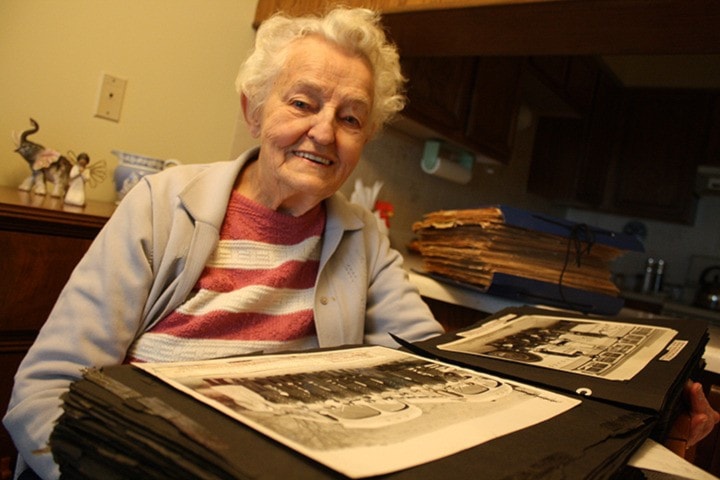Thirty-fifth in a series of pioneer profiles
Mary Carne has been recording the history of Greyhound for over 60 years.
Her bulging, foot-thick scrapbooks and photo albums constitute an incredible record of the company specifically and transportation generally in the Kootenays and Okanagan.
She packed her Brownie camera everywhere — earning her the nickname Mrs. Kodak — and meticulously typed captions for each print. She also saved ephemera including memos, ticket stubs, schedules, and passes that might not otherwise have survived.
Her association with the bus line dates back to her childhood in Winfield.
“It started in ‘32 because my dad didn’t drive much,” she says. “Then when I went to business college in Kelowna, every morning I used to go in on the bus and come back by train.”
She began working as a ticket agent in the Kelowna depot in late 1946 and after a little over two years transferred to Penticton. She moved to Nelson on a whim in August 1951, figuring she could always go back to the Okanagan, but never left.
At that time, Greyhound was at 221 Baker, where Sacred Ride is today, but soon after a new depot opened at the corner of Hall and Baker, now Sidewinders coffeehouse and Bia Boro.
The ticket booth, baggage room, and coffee shop were on the main floor while the washrooms and a restaurant called the Roundup Room were in the basement. The garage is now Boomtown Sports, and buses would pull into the alley between the two buildings and park in a vacant lot.
It was a busy terminal with three daily trips to Vancouver, and three more to Calgary, as well as twice-daily service to Trail, and daily runs to Kaslo and Nakusp. A one-way ticket to Vancouver was $12.35 and it took about 12 hours.
“We had a real good business,” Carne says. “It was just after the war. Not many people could afford cars and they travelled by bus. They took some big trips.”
One couple went to Vancouver, down the coast to California, across the southern US, and back up the east coast — all by bus. “The ticket was yards long, because they had to have a tear for each division point,” she says. “That was the biggest I ever made.”
In addition to passengers, Greyhound moved a lot of freight, as it was quicker and often cheaper than by truck or train. They also delivered newspapers to subscribers on the East Shore of Kootenay Lake — drivers tossed them out the window. At one place, Carne says, the bus stopped and a dog got on to fetch the paper.
While at the ticket counter, Mary met driver and Nelson native Max Carne, whom she married in 1956. Max usually had the Nakusp run, which left about 4 in the afternoon and returned at 10 the next morning — he only got to sleep in his own bed two nights a week. He also filled in for other drivers as far as Fernie and Penticton.
Drivers had to be prepared for all sorts of adversity, from snow slides to washouts to medical emergencies. Carne knows of babies born aboard buses, and drivers who spotted house fires. “The drivers often stopped to assist people off the road,” she says. “They were quite a courteous bunch. They helped one another.” (The Nelson division alone had over two dozen.)
The most treacherous route was the old highway between Rossland and Christina Lake, a glorified mud bog known as the Hump. They avoided it in winter by detouring through the US and in spring sometimes needed heavy equipment to pull them through.
Max once came across a circus transport trailer in the ditch and asked the driver if he needed help. “I already have help,” came the reply. Cue the elephants — who hauled the trailer out. (Max got several great snapshots.)
The opening of the Blueberry Paulson and Rogers and Kootenay passes in the 1960s was a boon for the bus line — but resulted in cancellation of Greyhound service to the East Shore. Before long, the Kaslo and Nakusp runs were also axed.
In 1963, the company dissolved its Nelson driver division, forcing drivers to move to either Penticton or Calgary. The Carnes were already packed and scouting for homes in Alberta when Max learned the City of Nelson needed a bus driver. He took the job and stayed for 23 years.
Mary left Greyhound soon after her wedding, but returned a few years later. She also worked at Eaton’s and spent a decade in the circulation department at the Nelson Daily News.
Today you may find her working at the IODE thrift store or at the hospital, where she’s one of four people who continue to hold vigil at the emergency room, monitoring comings and goings, a decade after service cuts.
Carne, 86, still adds Greyhound news to her scrapbooks, which have been exhibited at Gray Creek museum days and are destined for the local archives.
“I enjoyed my work with Greyhound very much,” she says. “They were a good company to work for and good people to work with. Just like one big family.”
Previous installments in this series
